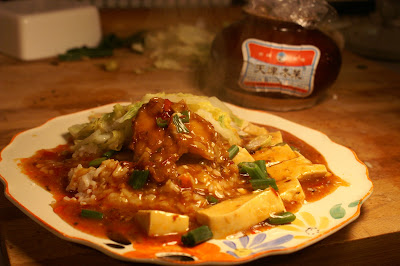This dish of braised fish and beancurd is fairly similar to the mapo tofu I made a week or two ago. It doesn’t have any minced meat in, rather some lumps of fish that are made extra tasty by being first fried. As Szechuan is an inland area the fish eaten there seem to be freshwater carp and catfish. FD recommends various substitutes (mullet here) but I had some odds and sods in the freezer which needed eating up so I used some snapper pieces that had been maturing in a drawer since their impromptu and purposeless purchase in Dalston over a year ago. They worked fine!
This one is of course another winner and tastes as might be expected. You get to enjoy the lovely soft beancurd, the hot and numbing spice combo and then the fried crust of the fish, now soaked in the delicious braising liquid.
Ingredient used fairly often in Szechuan recipes are the preserved vegetable ya cai (similar to the Tidjan ones available in shops) and preserved salted chillies. The Tianjin vegetables are pretty cheap and come in a pretty earthenware pot (visuals below). They have a real strong, salty taste and should be used almost as a seasoning I feel, chopped up small and mixed in with meat or veg. I don't have any Szechuan salted chillies yet so I substituted some pickled Turkish ones chopped up small. These two ingredients were tossed in with some stir-fried Chinese cabbage type thing (sorry, have no idea of real name - like a pale yellow/green long lettuce shape with a watery stem) and dressed with a minor sprinkling of sesame oil, which made a nice vegetable side dish. Like the mapo tofu this sauce was composed of stock and thickened. Scatter with spring onions greens and eat with rice. Super hearty.
This one is of course another winner and tastes as might be expected. You get to enjoy the lovely soft beancurd, the hot and numbing spice combo and then the fried crust of the fish, now soaked in the delicious braising liquid.
Ingredient used fairly often in Szechuan recipes are the preserved vegetable ya cai (similar to the Tidjan ones available in shops) and preserved salted chillies. The Tianjin vegetables are pretty cheap and come in a pretty earthenware pot (visuals below). They have a real strong, salty taste and should be used almost as a seasoning I feel, chopped up small and mixed in with meat or veg. I don't have any Szechuan salted chillies yet so I substituted some pickled Turkish ones chopped up small. These two ingredients were tossed in with some stir-fried Chinese cabbage type thing (sorry, have no idea of real name - like a pale yellow/green long lettuce shape with a watery stem) and dressed with a minor sprinkling of sesame oil, which made a nice vegetable side dish. Like the mapo tofu this sauce was composed of stock and thickened. Scatter with spring onions greens and eat with rice. Super hearty.






















